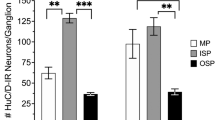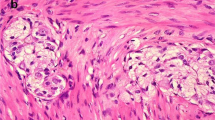Abstract
Alterations in interstitial cells of Cajal (ICC) distribution and density may seriously influence gut motility. We and others have documented a disturbance of ICC and neurons in Hirschsprung’s disease (HD), intestinal ischemia, and inflammation. The ability to remove intestine with permanent dysmotility improves significantly the prognosis. This may be important in the developing intestine especially in HD. More complete pathological information increases the accuracy of surgical decisions. Therefore we sought to develop a rapid, intraoperative immunohistochemical protocol for ICC and neurons in surgical specimens for routine diagnostic and therapeutic assessment of pediatric patients. To date, cKit is the only reliable immunohistochemistry for ICC identification. There are multiple antibodies in use for neuronal identification. A comparison of fixation methods and immunostaining using cKit and multiple intestinal neuronal antibodies was done. Fresh segments of surgically resected intestine were sectioned and stained using antibodies for ICC cell identification (anti-cKit) and for neuronal characterization. By carefully changing tissue fixation methods, different neuronal antibodies were tested to determine an optimal rapid protocol. Each suggested protocol was tested on normal and pathological intestinal tissue and compared to the previous overnight immunostaining of the same tissue. A new rapid tissue fixation and immunostaining protocol using cKit for ICC identification and NF 68 was developed. By employing this protocol, we could obtain ICC and neuro-immunohistochemistry in unfixed frozen sections within 1 h with tissue vibration to diminish the time for immunostaining. Without vibration the protocol takes 3 h. ICC and enteric neuronal changes could be readily observed and the quality of staining was comparable to standard immunohistochemistry. Each gut pathology displayed characteristic changes in ICC and neuronal density/distribution in the affected bowel. The time-scale of the 1-h immunoprocessing is still longer than the standard clinical pathological “quick” sections using H&E staining; however, the protocol duration is within the surgery timescale. Standard H&E stain used in combination with our rapid neuronal and ICC immunohistochemistry protocol enables a fast, comprehensive, and accurate assessment of the pathophysiology of signaling networks controlling gut motility while the patient is still in the operating room. We propose that the addition of this simple and rapid immunohistochemical assessment in the pathologist evaluation of surgical specimens would result in a more complete characterization for diagnosis and prognosis of the pediatric patient. Specifically, we propose that this test will differentiate good versus poor prognosis HD patients based on their neuron/ICC ratio and present a rapid, standardized method for use in general pathology.




Similar content being viewed by others
References
Maeda H, Yamagata A, Nishikawa S, Yoshinaga K, Kobayashi S, Nishi K, Nishikawa S (1992) Requirement of c-kit for development of intestinal pacemaker system. Development 116:369–375
Bettolli M, Bailey K, Khan H, Staines WA, Krantis A, Rubin S (2005) Quantifying interstitial cells of Cajal (ICCs): prediction of colonic dysmotility in post-surgical Hirschsprung’s patients. In: 38th meeting of Pacific Association of Pediatric Surgeons, Vancouver, 22–26 May 2005
Bettolli M, Khan H, Staines WA, Krantis A, Rubin S (2005) Distribution of interstitial cells of Cajal (ICC) in localized inflammation of the intestine. In: 37th meeting of the Canadian Association of Pediatric Surgeons, Quebec City, 22–25 September 2005
Chang IY, Glasgow NJ, Takayama I, Horiguchi K, Sanders KM, Ward SM (2001) Loss of interstitial cells of Cajal and development of electrical dysfunction in small bowel obstruction. J Physiol (Lond) 536:555–568
Jain D, Moussa K, Tandon M, Culpepper-Morgan J, Proctor DD (2003) Role of interstitial cells of Cajal in motility disorders of the bowel. Am J Gastroenterol 98:618–624
Porcher C, Baldo M, Henry M et al (2002) Deficiency of interstitial cells of the Cajal in the small intestine of patients with Crohn’s disease. Am J Gastroenterol 97:118–125
Rumessen JJ (1996) Ultra structure of interstitial cells of Cajal at the colonic submuscular border in patients with ulcerative colitis. Gastroenterology 111:1447–1455
Thuneberg L (1999) One hundred years of interstitial cells of Cajal. Microsc Res Tech 47:223–238
Sanders KM, Ördög T, Ward SM (2002) Physiology and pathophysiology of the interstitial cells of Cajal: from bench to bedside. IV. Genetic and animal models of GI motility disorders caused by loss of interstitial cells of Cajal. Am J Physiol 282:G747–G756
Taguchi T, Suita S, Masumoto K, Nagasaki A (2005) An abnormal distribution of C-kit positive cells in the normoganglionic segment can predict a poor clinical outcome in patients with Hirschsprung’s disease. Eur J Pediatr Surg 15(3):153–158
Jacobsen KX, Staines WA (2004) Vibration enhancement of slide-mounted immunofluorescence staining. J Neurosci Methods 15:137(1):71–77
Huizinga JD (1998) Neural injury, repair, and adaptation in the gastrointestinal tract. IV. Pathophysiology of gastrointestinal motility related to interstitial cells of Cajal. Am J Physiol 275:G381–G386
Huizinga JD (1999). Gastrointestinal peristalsis: joint action of enteric nerves system, smooth muscle, and Interstitial cells of Cajal. Micros Res Tech 47:239–247
Sanders KM, Torihashi S, Ördög T, Koh SD, Ward SM (1999) Development and plasticity of interstitial cells of Cajal. Neurogastroenterol Motil 11:311–338
Cajal SR (1889) Nuevas aplicaciones del metodo de coloracion de Golgi. Gaceta Medica Catalana 12:613–616
Cajal SR (1911) Histologie du système nerveux de l’homme et des vertebras, vol 2. Maloine, Paris, pp 891–942
Taxi J (1965) Contribution á l’étude des connexions des neurones moteurs du systeme nerveux sutonome. Ann Sci Nat Zool Biol Anim 7:413–674
Lecoin L, Gabella G, Le Douarin N (1996) Origin of the c-kit-positive interstitial cells in the avian bowel. Development 122:725–733
Huizinga JD, Thuneberg L, Kluppel M, Malysz J, Mikkelsen HB, Bernstein A (1995) W/kit gene required for interstitial cells of Cajal and for intestinal pacemaker activity. Nature 373:347–349
Torihashi S, Ward SM, Nishikawa SI, Nishi K, Kobayashi S, Sanders KM (1995) c-Kit Dependent development of interstitial cells and electrical activity in the murine gastrointestinal tract. Cell Tissue Res 280:97–111
Thuneberg L (1982) Interstitial cells of Cajal: intestinal pacemaker cells? Adv Anat Embryol Cell Biol 71:1–130
Thuneberg L (1989) Interstitial cells of Cajal. In: Schultz GS, Wood JD, Rauner BB (eds) Handbook of physiology, the gastrointestinal system. American Physiological Society, Bethesda, pp 349–386
Thuneberg L, Johansen V, Rumessen JJ, Andersen BG (1983) Interstitial cells of Cajal (ICC): selective uptake of methylene blue inhibits slow wave activity. In: Roman C (eds) Gastrointestinal motility. MTP Press, Lancaster, pp 495–502
Koh SD, Sanders KM, Ward SM (1998) Spontaneous electrical rhythmicity in cultured interstitial cells of Cajal from the murine small intestine. J Physiol (Lond) 80(513):203–213
Thomsen L, Robinson TL, Lee JCF, Farraway L, Hughes MJG, Rews DW, Huizinga JD (1998) Interstitial cells of Cajal generate a rhythmic pacemaker current. Nat Med 4:848–851
Costa M, Furness J (1982) Nervous control of intestinal motility. In: Bertaccini G (eds) Mediators and drugs in gastrointestinal motility, morphological basis and neurophysiological control. Springer, Berlin Heidelberg New York, pp 279–382
Author information
Authors and Affiliations
Corresponding author
Rights and permissions
About this article
Cite this article
Bettolli, M., Rubin, S.Z., Staines, W. et al. The use of rapid assessment of enteric ICC and neuronal morphology may improve patient management in pediatric surgery: a new clinical pathological protocol. Ped Surgery Int 22, 78–83 (2006). https://doi.org/10.1007/s00383-005-1586-3
Published:
Issue Date:
DOI: https://doi.org/10.1007/s00383-005-1586-3




